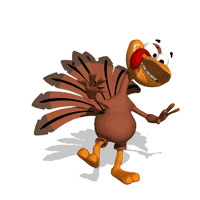Thanksgiving With an Asian Touch
ChinatownConnection.com
Happy Thanksgiving

Sponsored Ad
Asian Thanksgiving
(from SFgate.com)
The first Thanksgiving was fusion.
It was not the sexy fusion cuisine of today's chefs, but the daily meals
-- and especially the feast meals -- of the 1621 immigrants were
down-to- earth blendings borne of necessity and imagination.
Sustenance was the place where aching homesickness met abundant
adventure. Rare spices that had been pocketed by the Mayflower's
travelers were brought out to season native food; seeds that were
carried over were planted in new soil. Above all, the new arrivals
accustomed themselves to unfamiliar ways of eating in order to survive.
The cuisine of North America's early settlers was "a fabulous expression
of fusion," says Kathleen Curtin, food historian of Plimoth Plantation,
a living history museum in Plymouth, Mass., about the exchanges between
the settlers and natives.
"The immigrants brought seeds to plant and establish English gardens,"
says Curtin, but "those ingredients were add-ons. The basis of their
diet was turkey, wild fowl and venison, native pumpkins and corn," all
of them, new food.
It wasn't until the mid-19th century that the notion of a "First
Thanksgiving," referring to 1621, was created. The turkey meal as we
know it was distilled by social reformers into dogma, says Curtin. A
celebration of American values, and the concomitant proper menu,
although historically inaccurate, would be taught to the surging waves
of newcomers from Eastern and Southern Europe.
Through Thanksgiving, the reformers reasoned, the scourge of heavily
scented food could be removed, and the new immigrants would conform to
the mainstream.
But despite such attempts at a unified Thanksgiving, by the mid-20th
century the feast had swelled to a high tide of diversity. The holiday,
Curtin says, has evolved into "people celebrating their family or ethnic
traditions."
Food memories
My own Thanksgiving customs have continued to evolve ever since I
arrived from Thailand more than 30 years ago.
At first, I shared the meal with fellow students from overseas. Like the
1621 meal, it was a smorgasbord of dishes -- duck, geese and seafood,
along with remembered dishes from faraway shores. All were made with
fusions of locally-grown ingredients and spices hand-carried from homes
abroad. The food triggered intense memories of other places.
The menus morphed through time. Friends, family, evolving self-identity
and all the encounters and exchanges of, well, life, all contributed
ingredients to each year's menu. Some recipes stuck. Roots sank.
Traditions began.
The turkey always lurked -- should I or shouldn't I include it? Sure
enough, soon after I married, it appeared at my table because my
American-born husband had to have the bird. For many other immigrants,
"children are the reason you have the turkey," says Curtin, because kids
want to go back to school and say they had turkey.
A new bird beckons
Last year, I abandoned the Cajun-Alabama-Korean-Thai infused turkey that
I had made for many years, a blending of flavors from my own background
and that of my ex-husband's. I chose a classic Chinese technique of
cooking the gravy -- a dipping sauce, really -- inside the cavity of the
bird, and tweaked The Chronicle's Food staff's Best Way turkey brine
with the classic flavors of ginger, star anise and fennel seeds. It
worked beautifully with the new generation of free-range turkeys.
Stuffing is the second most popular idealized Thanksgiving dish to
appear on immigrant tables, says Curtin -- "It's where the cultural
flavors pop out. " Ethnic cooks, in a tradition that's 400 years old,
have fleshed out the stuffing with staples of the old country, from
couscous to masa to noodles to rice to breads of all varieties. Because,
as Curtin says, "People tend to take their own cooking techniques and
flavors," my stuffing is based on glutinous rice studded with sausage
and shiitake mushrooms, wrapped in a lotus leaf and gently cooked in
steam, an Asian technique. Gourds are mainstays in Asian cuisines, so I
wanted to include the American pumpkin. I recalled a classic Chinese
soup stewed slowly inside a winter melon, a gourd, where the interplay
of the sweet meat of the gourd and the rich meatiness of the broth
produces a wonderful fusion. To translate that to pumpkin, I reached for
the Thai flavors of dtom kaa (coconut-galangal soup) to bridge the
American squash's nutty flavors.
Sugar was a precious commodity to the colonists, so cranberries, which
they incorporated about 30 years after landing, were not sweetened.
Instead, they were likely made into vinegar. But by the late 20th
century, things had reversed: sugar was cheap and my attitude had swung
180 degrees. I was desperately trying to remove the sugar from cloyingly
sweet cranberry sauce and came up with a cranberry chutney sweetened
primarily with the natural sugars of cider and fresh and dried fruits,
and infused with fresh ginger, star anise and cinnamon.
Forgiving beans
For a side vegetable dish, I stir-fry long beans. I don't grow the
beans, but I can imagine Asian immigrant farmers growing them from seeds
brought generations ago. The beans' slightly astringent, nutty flavor
stands up to the turkey, while their long-holding crunchy texture means
that a harried cook can make them ahead of time.
I was elated when I discovered that the persimmon, a beloved fruit in
China, is native, too, to North America. That cleared the way for me to
create a tart using the two commercial varieties of Asian persimmon, the
Fuyu and Hachiya, cousins to the native fruit, in a single dish, and to
serve it over an almond tart base.
"People always look for distinctions between cuisines, but so much more
is similar. So much more ties us together," says Curtin. That includes
the greatest tie of all, which for me has become the central teaching of
Thanksgiving -- that we're all immigrants to this planet.
(contributed by Olivia
Wu, Chronicle Staff Writer)